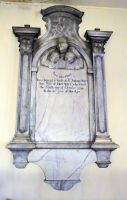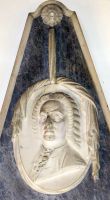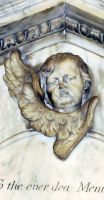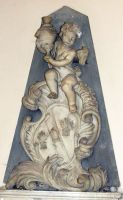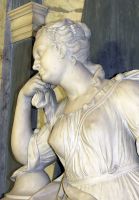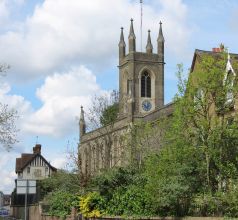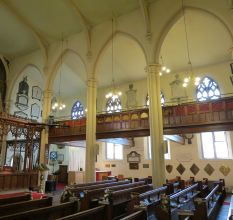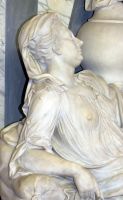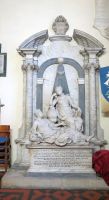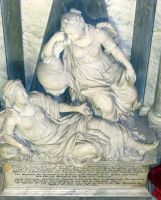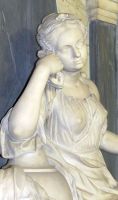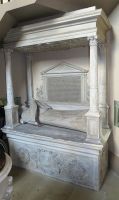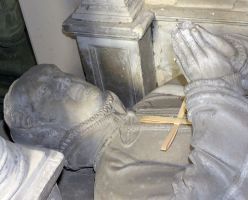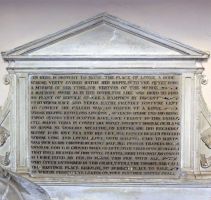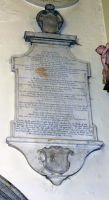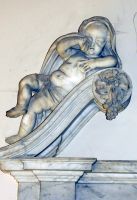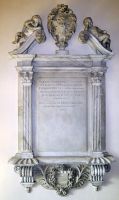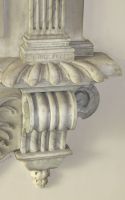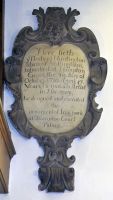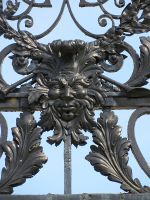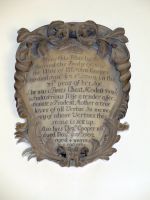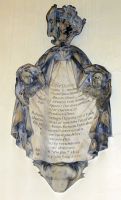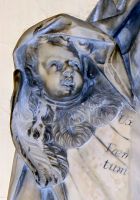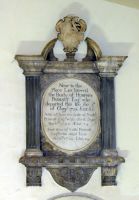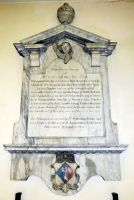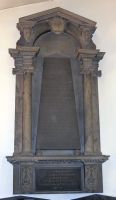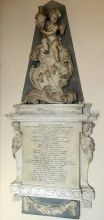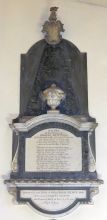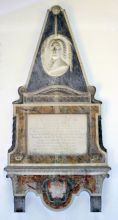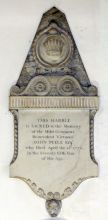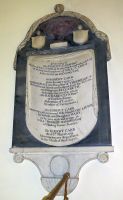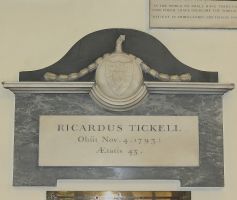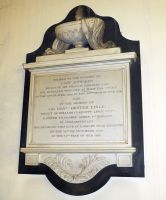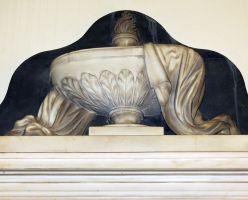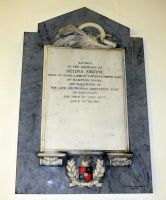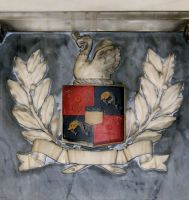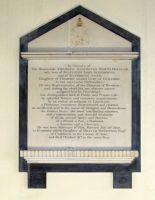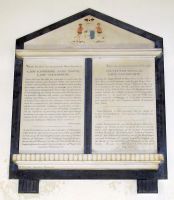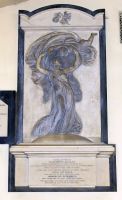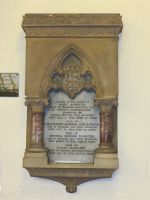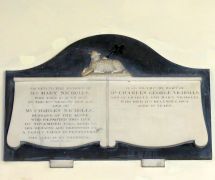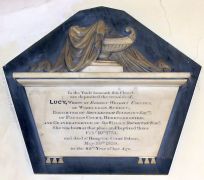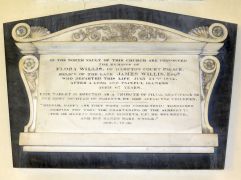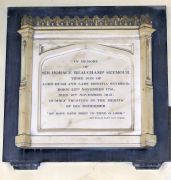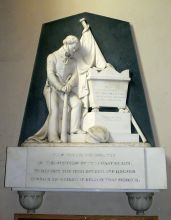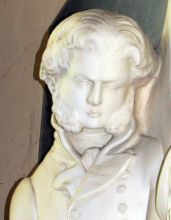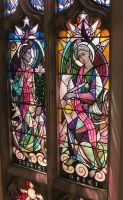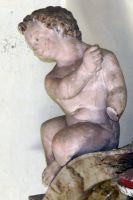Hampton Church (St Mary's, Hampton) - Monuments
Hampton Church is of interest to these pages for its large number of monuments over eighty in all, not including the modern brasses. Many of those commemorated were linked with or lived in Hampton Court Palace, though that is not the focus of this website.
Saint Mary s Hampton dates from 1829-31, replacing a medieval building, and in style is a standard Gothic with pinnacles on the nave and the square tower. Inside, the Church has slender clustered pillars marking rather than dividing off the aisles, and galleries to both sides. Panel monuments mostly dating from the previous building hang everywhere, some skied, some in the galleries.
St Mary's Church, Hampton.
There are two impressive figure monuments, to Susannah Thomas, d.1731, and the earliest in the Church, Sibel Penn, d.1562. We start with these, then the rest in date order, leaving the plain ones after 1770 to the end. As an ensemble, there is a complete run of almost every decade from 1700-1870, meaning we can see in this one Church the change through the variety of pillared and pedimented Classical panels of the 18th Century, as well as several cartouches and obelisk monuments, both noble types. Then from the 1790s, comes the shift to the many plainer white-on-black tomb-chest ends and simpler panels. As well as the Susannah Thomas sculptor, William Powell of Hampton or more likely Henry Cheere, the panels include several signed works including by Robert Blore and Bedford of 256 Oxford Street, both quite known, and others more obscure.
Monuments - large figural sculpture
Susannah Thomas, d.1731, and her mother, Dame Dorothy [Chettle], d.1726. The principal monument in the Church. The statues of mother and daughter form a group, in full Classical drapery, but posed as if in casual conversation, a popular mode of the time to bring those represented close to the viewer, intimate, alive. The mother reclines, Roman fashion, her elbow propped on a plump pillow, that hand clasping a fistful of drapery, her other hand extended in a gesture to illustrate some point. Her feet are crossed, adding to the sense of relaxedness conveyed by the superbly nonchalant pose of her head, backwards and looking somewhat upward. Her daughter is seated behind and towards her feet, one elbow crocked on a funereal urn in that somewhat disrespectful but characteristic way of the 18th Century mourner, her other arm resting on a book, which, put aside to listen, she still props open with finger and thumb to mark her page. There is the strongest family resemblance between the two, with somewhat idealised figures rather fuller than the ideal of the Victorian era, noticeable double chins, a sense of opulence and good living. The leaning forward pose of the seated figure gives the ensemble a carefully balanced pyramidal composition. They are within a grand setting: tall pillars on either side support an open, curved broken pediment, containing the cartouche of arms at the top, all very Baroque with receding pillar and pediment elements. In the background, a curved arch and tall obelisk crowned with a ball. The heavy base of the monument bears the inscription. William Powell of Hampton is given as the sculptor, obscure and not known for other significant works, and Lysons the historian has no hesitation in ascribing the monument rather to his teacher, the gifted Henry Cheere; Gunnis the sculptural historian more cautiously suggests that most of the carving may have been done by Cheere.
Sibel Penn, d.1562.
Sibel Penn, d.1562, nurse to Edward VI, with a lengthy if uninformative eulogy behind the reclining full-length recumbent figure, within a four-poster bed style monument, made up of canopy, fluted multipartite Corinthian columns (pilasters at the rear), and heavy altar tomb below with carved arms on front and ends (it is somewhat crammed against the stair of the south porch of the Church). The figure itself is rather plain: grim, blank faced portrait above a thin ruff, not viewable from in front of the monument by virtue of an obscuring pillar, sweeping sleeves with hands raised in prayer, conventional, plain long cloak with no sense of gravity, and small feet and the hem of her dress tucked underneath at the other end. Minor ornament on the pillars and coffered ceiling, and strapwork flanking the inscribed panel, but this monument has been somewhat mauled and likely was highly painted and with other features now lost.
Susannah Thomas, d.1731, and Dame Dorothy, d.1726, by Henry Cheere/William Powell of Hampton.
Panel monuments in date order:
Edmond Pigeon, Yeoman of the Jewell House to Henry VIII through to Queen Elizabeth who made him also Clerke of her robes and wardrobes , and son Nickolas Pigeon, d.1619, who took on both offices. A tiny panel below writes that the latter s daughter Alice married Sackvile Mason who erected the monument. This post 1619 date feels right as an example of a type which came in about this time and persisted through the 17th Century, with the odd case past 1700 black, framed panel with flanking pillars, Baroque broken pediment above with a large shield of arms in the centre, all in brownish-pink alabaster or marble. On top, a flanking pair of cherubs, painted in flesh tones making them rather abominable, one clutching the remnant of perhaps a flagpole. (Lots of cherub sculpture on this page.) At the base on the apron is a smaller, painted cartouche of arms. A noble piece.
Alabaster Pigeon monument, and cooler-toned panel to Richard Bynns.
Henry Cooper, d.1687, Clarke of the works att Hampton Court and wife Margarett Cooper, d.1700, plain streaky marble panel with stone frame.
Jane Cooper, d.1702, a Pious Chast[e] Modest Frug ll & Industrious Wife, a tender affectionate & Prudent Mother, a true lover of all Vertue , and Elizabeth Cooper, d.1702, aged just four. The monument is not frugal, but a charming cartouche, shaped like a turtle s carapace with an elegantly carved composition of olive and palm leaves and shelly curls to the sides see picture lower down. The earliest of three full cartouche panels in the Church, a more sculptural alternative to the rectangular format.
Mrs Frances Ball, d.1704, Classical Baroque panel by Thomas Hill.
Mrs Frances (Watts) Ball, d.1704, and Edward Ball, d.1702. Elegant and ornate Classical panel in streaky white marble almost a century on from the Pigeon monument, and the same elements have moved from a sumptious, dark panel to a cooler, Baroque structure. The central panel is flanked with fluted Corinthian pilasters, with gadrooned (corrugated) based and an entablature above. Above this is a pediment, taken to a lightness and Baroqueness rather extreme, for it is of the type called swan-necked, thus broken at the top and with S-shaped (or swan-neck shaped) sides curled round. In the open space in the middle stands a large, ornately carved shield of arms based on a small shield borne by a lion in low relief, and surrounded by scrolls. The insubstantiality of the structure is emphasised by the removal of the backing usually found in pediments, making the curved side-edges look particularly precarious, especially as on each lounges a mourning cherub. At the bottom of the main panel is a shelf, with curly brackets supporting the pilasters, and a central field with a sharply-cut design of two boughs around a central shelf of arms with scrolling; the undercutting is extreme to highlight the delicacy and mastery of the sculptor. He signs at the base of one of the pillars, rather discreetly, as T. Hill. He is Thomas Hill, a statuary and mason who did much work at Hampton Court Palace, Kensington Palace, and St Paul s Cathedral, among other things. His oeuvre included decorative urns and chimneypieces and the like, and only a handful of church monuments, so most interesting to see this one as an example of his careful work. He died in 1713.
Huntington Shaw of Nottingham, d.1710.
Huntington Shaw of Nottingham, d.1710, He was an Artist in His way , saying too that he designed and executed the ornamental Iron work at Hampton Court Palace. Well, Sir Reginald Blomfield no less wrote in 1900 that it has been ascertained that the words in the inscription in question were added in 1833 , and that Shaw was rather an assistant to (or wrought to the design of) the eminent wrought iron artist Jean Tijou, who, Blomfield continues, was apparently employed at Hampton Court as early as 1670. An illustration by Lyson, the historian, dating no later than 1811, now in Yale, shows the inscription ended in his way which would agree with this. However, it seems that Shaw was at least associated with the Hampton Court gate (screen) at the time of the monument being erected a century earlier, as above the inscription is a curious face-like design which looks like a very loose approximation of a face from the Hampton Court screen (you will need to click to enlarge the small picture above left to compare it to the ironwork in the centre). At the end of the Victorian period Huntington Shaw remained in high repute, with a statue among the ensemble of artists represented on the front of the Victoria and Albert Museum (by the sculptor Abraham Broadbent] he is there shown carrying a carving of a similar face (above right). Incidentally, the Yale watercolour shows the cartouche panel as being outside the Church, against the wall, on top of a grandly constructed base seated on a great tomb chest, decorated with panels carved with skull and bones and symbols of mortality (scythe, hourglass). Well, back to our surviving monument a cartouche then, with apart from the face on top, a conventional treatment of scrolls and leaves around the central panel, and an elongate base broken off at the bottom, explained by this being the surviving bit of the larger monument. Tall panel with curly sidepieces, upper curved shelf bearing a cartouche of arms, lower shelf and apron, and winged cherub head at the base.
Richard Pluckington, d.1712, brightly regilt small wooden panel with scrolly jigsaw cut shape, painted cherubic scene above and minor floral decoration below. Wants to be left in bright light or over a tallow candle for a few decades, to darken the over enthusiastic regilding somewhat.
Sarah Witt, d.1719, variant on the Mrs Ball design. The inscribed panel is topped by three winged cherub heads within an arch, pilasters to the sides with large capitals, supporting the bases of vanished urns or torches or other devices; between them, a raised curly pediment section, with low relief carving of entwined branches and a very pagan snake swallowing its tail in the Nordic symbolism for rebirth. Likely, there would once have been some coat of arms or pot on top. Curved, blank apron at the base. See picture at top of the page.
Marriott family through to 1721, starting with James Marriott, d.1711, his wife Anne [Haughton], d.1714, and sons Henry Marriott, Richard Marriott, d.1721, and Thomas Marriott. Curved and flattened pediment above with flamboyant arms above; the side pillars receding and reduced to curly ornaments; shaped apron below, and a single supporting winged cherub head.
Humphry Primatt, d.1728, and added later, Ann Primatt, d.1733, and her husband Nathaniel Primatt, d.1751. The inscription on an oval surrounded by low relief carving: winged cherub heads above, and skulls and bones below as memento mori. Heavy fluted black pillars to the sides, bearing a shelf with a broken pediment, and central cartouche of arms with some remaining paint. At the base, curly supports with more relief carving, and small central apron with triplet of winged cherub heads. The dark surround, the low relief carving, and the big arms above all hearken to the past, and the monument would hardly have looked out of place a hundred years earlier: what a contrast to the other pillared panels of similar date. A picture with other Classical panels is a bit further down, left.
Bynnes family, erected by Anne [Bynns] Shadwell, d.1777, after the death of her mother Anne [Trumball] Bynns, d.1729, and before the death of her husband John Shadwell, d.1747. The first commemorated ancestor is Richard Bynns, d.1702. Panel with cut outs to top and sides, a thin frame, an upper shelf bearing a cartouche of arms, and a bell-shaped apron below also bearing a cartouche. Quite disproportionate, it may be that the top and base are from an earlier panel, replaced by the central piece, or there is something else missing. Picture below, 2nd left.
Cartouche panels in Hampton Church: Cooper and Tilson.
Anna Tilson, d.1730, with a long Latin inscription, on the third cartouche in the Church, equally interesting to the previous two. Cartouches often have the carved border made of gathered drapery, knotted at the top, or, as here, around the heads of a pair of winged cherub heads - see pictures above, centre and right. At the base is often a mini cartouche bearing a coat of arms or suchlike here we have the obscure P.M.S. Lugens F G.T. , with the F perhaps being Fecit as in the sculptor who made the monument. On top, a painted shield of arms, again in Cartouche style, knocked askew and perhaps not in original position. The unusual feature is that the inscription is on a carved hanging drape, whereas for a cartouche we generally expect a smooth backing. Anyway, a rather mauled piece, with the base as well as the top pushed together rather than having the look and feel of being in quite their original positions.
George Tilson, d.1738, Armiger [ie someone entitled to bear arms]. A Foreign Office official. A most fine example of an obelisk monument - see picture a little further down with other obelisk panels. Such things typically come with an upper obelisk of flat, dark marble, bearing some device or figure, a central shelf or division, and a lower piece with the inscription and more or less decoration (lots more about obelisk monuments on this page). Here, that decoration consists of a shelf with wavy patterns in low relief, under which is a carved garland, below, and to the sides, outward-facing half-cherubs, acting as pillars supporting the shelf, nicely Baroque. But the dominating feature is above, where the obelisk is almost eclipsed by a cartouche taken to extremes of twisted scrolliness, bearing the Tilson arms, with a lively cherub seated on top of it holding a small funereal urn. Splendid.
Variations in Classical panels in Hampton Church from the earlier 18th Century.
Catherine Proger, d.1739, daughter and co-heir of the Hon. Edward Proger, d.1713, also commemorated, and listing his offices which included being MP for Brecknockshire and serving both Charles I and II. Erected by Sir Sydenham Fowke and Dame Frances his wife; he was sister of Catherine. Large panel with flowing script, and surround of streaky marble, almost completely open pediment above with a central winged cherub head, and a pot on top. At the base, a shelf and apron bearing a painted coat of arms within a cartouche. The side pillars have been reduced to a frame, foreshadowing the plainer monuments to come (see picture above, 2nd from right).
Somersett English, d.1741, Yeoman of his Majesty s Woodyard , and on a separate lower panel, his wife Judith English, d.1766. Another large monument, with the inscription on a tapered obelisk, wide at the top, resting on ball-feet. To the sides, free standing Ionic pillars, supporting an arch underneath an open pediment, under which is the now blank shield of arms, with winged cherub heads to the sides. A shelf underneath is supported on two brackets with low relief flowers depending from tied bows, and between, the small panel to Mrs. English. Picture above, far right.
Obelisk monuments in Hampton Church: Tilson, Selwyn, Dillingham, and the Virtuous Peele.
Charles Selwyn, d.1749, with a poem, and added on a small panel beneath, his wife Anna Maria Selwyn, d.1768. Picture above, second from left. An obelisk monument of sorts, to be compared with the Dillingham monument and the Tilson monument. The proportions are very similar to the Dillingham monument: the obelisk being a little under half the total height, the fireplace-like frame to the inscription taking the majority of the space below, but broader than it is high, and below a substantial lower shelf, the base or apron taking up perhaps a sixth of the total height. For Selwyn, the obelisk is a very dark marble with whitish veins, and unusually has its own backing panel, almost square with a curved top. At the summit of the obelisk, the arms in a nice cartouche; in front, a decorated funereal urn of no great size. The central shelf is also upwardly curved, with minor low relief decoration there and on the curly sidepieces to the inscribed panel below. The lower shelf is heavily fluted, in ancient style, and Anna Maria Selwyn s inscription below has a downward curve at the base reflecting that above, and with further slight decoration to the sides.
Mary Gavell, d.1749, combined memorial and record of her testament, including 100 to be put out to interest to be given in Bread for the poor that comes to Church in Hampton Parish , none of it to the Wick , and another 20 for Hampton Parish bread. And a Board in the Church to hold the Bread. Plain panel with narrow frame, fittingly with a breadboard on top.
Theophilus Dillingham, d.1769, son of the similarly named Archdeacon of Bedford. An obelisk monument from the best period of such things, thus in coloured marbles and with a medallion portrait of the deceased wearing a wig. This is in white marble on the brecciated black marble or darkened serpentinite backing obelisk, as if hung from a flowery peg with hanging drapes. Beneath, rather than a shelf we have a flattened, curved pediment with low relief carving, airy and light, forming the upper for the inscribed panel, also in white and surrounded by a favoured yellow-and-black marble. A lower white shelf, then a red and white marble base, with Baroque outline, bearing the little coat of arms, itself in different colours, and with dark supports. An excellent monument of its type - see picture above, 2nd from right.
John Peele, d.1770, Mild, Generous, Benevolent, Virtuous . A shorter obelisk monument, much ornamented on the obelisk itself - picture above, far right. We see a crown within inner and outer near-circular borders, the outer one being a wreath, with scroll at the base. Below, curly high relief decorations with flowers and leaves in low relief, a corrugated central shelf, and the inscription underneath with little flowers to the sides, scrolly leaves at the base and a terminus. Overall a light, elegant piece.
After this point, we pick just the less plain pieces; see list of the rest.
The transition to the white-on-black panels of the early 19th Century: Carr and Tickell.
Sir Robert Carr, Baronet, d.1791, noting his two marriages and offspring. This fairly early white on black panel has the inscription on a hanging drape, lightly carved, on a shaped backing panel with two shields of arms above flanking a pot, under a curved-pediment of drapery knotted at the top - picture above left. At the base, a curvy apron with circlets and a jelly-mould base. The pot above is in a dark red stone, and the whole is a rather interesting transitional tablet, between the more decorated and colourful earlier panels, and the plainer and more conventional white-on-black panels which were beginning to predominate at and after this time.
Cyrus Maigre, d.1792, and daughter Ann Maigre, d.1777, modest white panel with upper entablature and shelf, thinner lower shelf and two curly brackets.
Richard Tickell, d.1793, with the briefest of Latin inscriptions. On a grey streaky marble backing, with upper shelf, dipped in the middle to hold a medallion with low relief shield of arms, and a trail of simple flowers across its top; the backing to this upper part is a wavy pediment shape of black marble. Picture above right.
Robert Blore's panel to Lady Edwards, d.1805.
Lady Edwards, d.1805, wife of Sir Francis Edwards, Baronet, and the Hon. Hester Lisle, d.1828. Classical panel with narrow frame, upper and lower shelf. Above is a finely carved, draped pot with a flame emerging from the top, on a wavy black backing, rather unusual. At the base, between two blocks, is the apron, bearing crossed branches carved in relief. By the statuary Robert Blore, Piccadilly, London - it was actually a father and son partnership, with quite a wide oeuvre of monuments in churches far and wide.
Ann Cole, d.1765 and son William Cole, d.1807, gilt on black wooden panel with low relief carving of cherub head, plants, scrolls above, and pot and two small flaming cups above, winged skull and more floral things a the base, repeating flowers down the sides. Very brightly gilt, as he left the sum of one thousand pounds to this parish the interest to be applied to keep this tablet and inscription in repair, and the surplus to poor persons .
Sir Richard Westmacott RA's panel to Selina Smith, d.1817.
Selina Smith, d.1817, with a scythe and cut corn above, symbolising her death while in the full ripeness of her life, scrolly, leafy supports, and carved and painted coat of arms below, on a pleasant light grey and black marble base cut with pediment at the top. Signed by Richard Westmacott, London. A bit too early for the third in the Richard Westmacott dynasty, so this would be by the more eminent and very prolific sculptor Sir Richard Westmacott RA.
Mary Anderson, d.1818, with feet and two shelves, and bearing upon each foot a carved flower. On a shaped black backing. These sorts of panels, styled as a tomb chest end, were very popular others are noted in the list of plainer panels.
Richard Wilford of Dean Street, Westminster, simple b/w panels to Douglas and Glenbervie.
The Hon. Frederic Sylvester North Douglas, d.1819, just 28 years old, and was MP for Banbury during his short but not obscure career , with a eulogy. With upper and lower shelf, and cut to a tall pediment shape above, which has lost its coat of arms. On a shaped black backing, and looking to have lost some attached devices on the feet. Signed by the mason, Richard Wilford, obscure, but someone whom we shall meet again below in the Grenbervie monument.
Edward Strettell, d.1821, Advocate General of Bengal, erected by his wife. A white on black monument reverting to the earlier obelisk style, sort of. The obelisk as a dark plain sheet is cut with tapering sides but a Gothic arch top, but still, an obelisk. Upon it is a short pillar bearing a dying tree, on the front the pelican feeding its young, very small, and at the base the collapsed pillar capital (Ionic) and two books. All resting on a shelf, with the lower part bearing the inscription and with fluted, plain side pilasters, rather short.
Lady Katherine Anne North, Lady Glenbervie, d.1817, and her husband Sylvester Douglas, Lord Glenbervie, d.1823. Twin panels sharing a common upper and lower shelf, on top of which rests a marble slab cut to uneasy pediment shape bearing a worn painted shield of arms with two flanking male figures. With a meagre black backing, resting on two small supports, and signed on the lower shelf by the mason, Richard Wilford of Dean Street, Westminster. Picture above right.
Frances Maria Greentree, d.1825, infant daughter of parents on the Island of St Helena, with a poem. Carved as a casket tomb, really quite three dimensional, protruding well out from the backing panel, assembled rather than carved to shape. It stands on lion s feet, on a thick shelf with Roman S patterning, and has a nicely proportioned lid. On a grey, striated backing panel cut to a faceted shape.
Elizabeth Seymour, d.1827.
Elizabeth Mallet Seymour, d.1827, wife of Horace Beauchamp Seymour MP, and their daughters Jane Seymour, d.1823, an infant, and Gertrude Elizabeth Seymour, d.1829, just two years old. The majority of the monument is made up of a spending high relief sculpture representing the soul of the deceased, being pulled heavenwards by a wingless cherub. The youthful woman stands arms outwards and upwards, a dramatic gesture, her arms and those of the cherub forming an oval. She wears thin drapes modelled in more of a Byzantine than a Grecian style, emphasising the surfaces of stomach and thigh, one breast bared, swirls of drapery behind at base and above, and hair down to her waist on either side. A splendid composition. Above, cut to eared, curved pediment shape and bearing a carving of a rose cut off in its prime. On a thin, shaped black backing.
Letitia Maria Williams, d.1829, tall panel with Latin inscription, upper pediment with a carving of a butterfly about to take wing from a broken stem of corn, thus the freed soul going to Heaven. The upper shelf bears low relief ornament, as does one of the supports to the lower shelf; the piece is signed on the black backing by Wallace &? Whyte of Edinburgh.
Catherine Henrietta Rowlls, d.1830, as a tomb chest end with upper and lower shelves, block feet, and with a carved pot, rather wide, in relief at the top. On a shaped black backing. Signed, but I did not write down by who.
19th Century Gothic Bowater panel.
Mary [Bayley] Bowater, d.1790, sons Lt.-Gen John Bowater, d.1813 and Admiral Edward Bowater, d.1829, and the latter's wife Louisa Bowater, d.1835. A Gothic window monument, with the inscribed marble panel within the window, cusped and enclosing a circlet bearing the IHS symbol, with a plain orangey stone surround, resting on short, red and white marble pillars. Below, an apron, and this and the upper shelf of the panel, in the same stone, are lightly carved with repeating patterns. This piece was, I would think, made after 1835, and perhaps some years afterwards, as although Gothic panels did make a reappearance from early Victorian times, the polished pillars are more characteristic of the 1860s.
Alicia Pottinger, d.1836, tall panel with weighty base, upper shelf with repeating Egyptian leaves, surmounted by a Pelican with the motto Fuimus [we have been], and above the inscription but below the shelf, another heraldic carving with the words Virtus in ardua [loosely, Virtue or strength through hardship ]. On a grey-black backing, signed by the statuary, Bedford of 256 Oxford Street, whom we shall meet again on the later Capt. Ellice panel.
Mrs Norbury Kerby, d.1836, with no first name given with a lengthy eulogy from her daughter who erected the tablet. Pillars to the sides, shelf and blocky pediment above bearing crossed palm leaves, and shield of arms in low relief below her husband was the Hon. Thomas Norbury Kerby, of Antigua. On a black shaped backing.
Thomas Carr, d.1837, of Hampton and John Street, Bedford Row, London, and his wife Susan Carr, d.1850. Same design as the Kerby panel above.
Later white-on-black panels in Hampton Church.
Mary Nicholls, d.1837, her husband Charles Nicholls, d.1823, and their son Charles George Nicholls, d.1861. A double panel, parents to the left, the offspring to the right, and room for other names to have been included. Each panel has a curvy outer side and feet, and a common upper shelf, bearing a carved Lamb of God. On a black backing cut with a curve at the top. Picture above left.
Lucy (Boughton) Wright, d.1839, noting her father was Shuckburgh Boughton, her grandfather Sir William Boughton, Baronet. As a casket end, standing on small triangle feet, with outward slanting sides, an upper lid, and a relief of a broad, Oriental looking lamp on top, partially covered with drapery, carved in spirited fashion. On an almost pentagonal black backing. 2nd picture above.
Flora Willis, d.1842, rather elegant tomb chest end, embellished with curly side pieces, and a low, curved pediment where the outer edges curl up to form the acroteria; each curl has within it a carved five-petalled flower, and there are more flowers carved in high relief in the pediment. On a black shaped pediment. The stonemason was aptly named G. Mason of Hampton. 3rd picture above.
Sir Horace Beauchamp Seymour, d.1851, husband of Elizabeth noted above. Carved as a Tudor window, one of just two Gothic pieces in the Church, the inscription being on the blind pane, within a broad border, with to the sides, protruding pilasters more like towers, with tall lights, and at the top a line of castellations of stylised leaves. Lt. Col Seymour is noted in the plain panels below. Picture above right.
Captain Ellice, by the prominent statuary Bedford of 256 Oxford Street.
Captain Alexander Ellice, d.1853, erected by the officers of the Coat Guard. Our last figure sculpture, in white marble against a black backing, of a soldier standing next to a chest-tomb. He is a youthful figure sporting sideburns, stands with head bowed in sorrow, bareheaded, his cap being tossed on the ground in front of the plinth on which the memorial is placed. One foot is raised on the step, and his two hands lean on the end of his extended spyglass. We see one end of the chest tomb, or casket, with the inscription upon it, and lying against it a partly unfurled flag. Figure, tomb and flag together make a good triangular composition with varied surfaces. Below all this is a thick base, bearing the remainder of the inscription, supported on two corbels carved with stylised leaves. The face is carved rather simply, and with an unlined purity and little lips unbecoming for a grown man, and the drapery on his limbs is rather simple and somewhat tubular on the legs, but this is made up for by the composition, and the several minor features which clearly the sculptor delights in: the lion feet to the tomb, the little cord on the flagpole, the pair of pistols stuck in the sailor s belt. The piece is signed by Bedford, of 256 Oxford Street, and this is an unusually sophisticated work for a firm (father and son) most familiar from various rather simple white-on-black panels around various London churches, with a minimum of sculptural ornament.
Charlotte Miller Mulford, d.1874, white on black cut in the form of a curling parchment, a style widely found though never in great numbers, as an alternative to a plain rectangular panel.
Robert George Graham, d.1922, Chief of the Hampton Volunteer Fire Brigade, etc, and wife Alice Graham, d.1938. A late Arts and Crafts style panel, with a crucifix and low relief fireman s helmet and phoenix above in small panels, a broad border carved with stylised leaves and Tudorish flowers again in low relief, and an outer frame of serpentinite.
Other, simpler panels after 1770 in the Church are noted on this page.
Alas, I did not get to see all the monuments, including one by the notable sculptor JCF Rossi. One panel with a portrait head was obscured; others are noted by Lysons the historian.
Modern brasses
There are several brass panels of a type popular at the end of the 19th and early 20th Century, including a row with two shield-shaped ones. We may note: Arthur Brandt Holberton, d.1881, a former pupil of Hampton Grammar School who was drowned in the Thames while endeavouring to rescue his companions , with a narrow border of repeating leaves and flowers, between red lines; Alice Jane Lawrence, more ornate with cross in a Gothic window, and five-point leaves, tendrils and flowers; and next to this is Jane Lawrence, again with wide border and cross at the top. I did not see the two 17th Century brasss inscriptions.
Wooden statue, modern stained glass, font in Hampton Church.
Also in the Church:
- Roundel with Virgin and Child and two angels, painted stone with mosaic haloes. Arts and Crafts period.
- Round font, presumably 18th Century, by the stairs.
- Several large paintings after the Italian.
- Some stained glass, of which most notable is the modern Gabriel and Uriel in dark pastel colours.
- Several wooden statues of saints.
- Royal coat of arms, painted, dating from when the modern church was put up.
The St Mary's Hampton Church website is at https://www.hampton-church.org.uk/.
One of the cherubs on the monument to Edmund Pigeon, after 1619.
North-East to Teddington Church and thence Twickenham Church // East to Diana in Bushy Park // South to Christ Church, Esher and St George, Esher // South West to Walton on Thames Church
